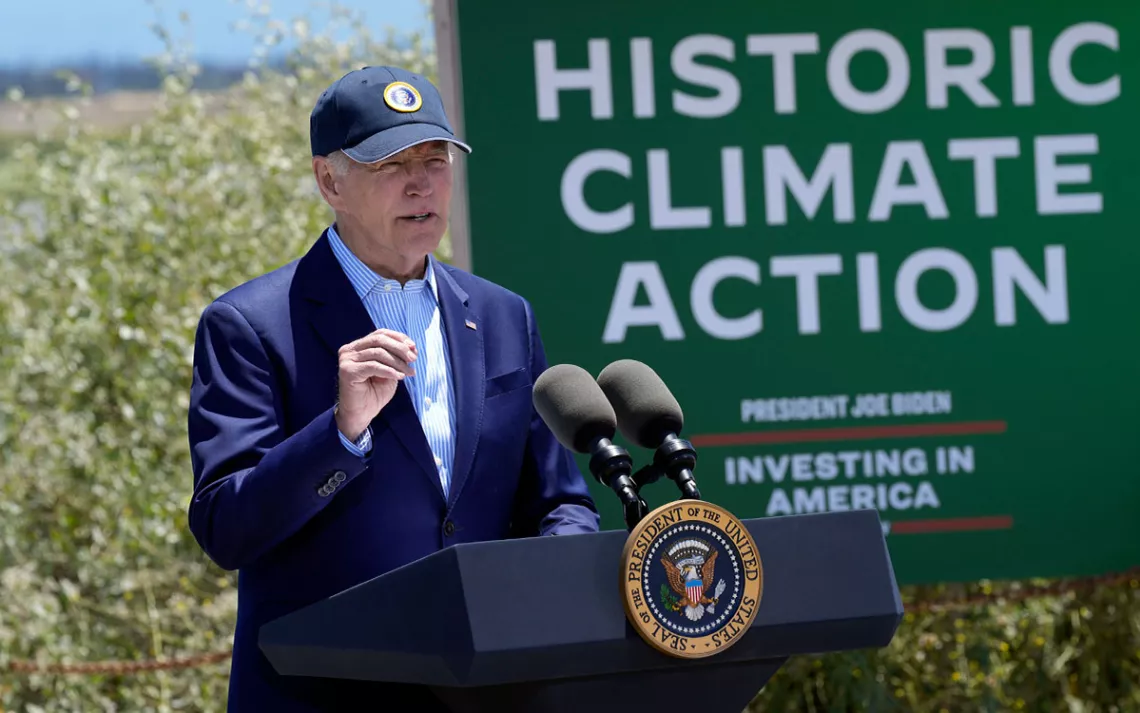The Environmental Victories Keep on Comin’
A cheat sheet for tracking the flood of good news from the Biden administration

President Joe Biden speaks at the Lucy Evans Baylands Nature Interpretive Center and Preserve in Palo Alto, California. | Photo by Susan Walsh/AP
The Biden administration is on a roll when it comes to putting in place strong standards to protect our wildlands, safeguard clean water, and tackle the climate crisis. In the last couple of months, federal agencies have issued a flood of new rules to bolster renewable energy and conserve natural landscapes. Taken together, the raft of administration actions represents a truly historic, unprecedented presidential commitment to environmental protection. Melinda Pierce, legislative director for the Sierra Club, says that Biden “has the most ambitious climate and environmental agenda of any president in history.”
“All of this in the lead-up to Earth Day has been breathtaking,” says Pierce, referring to the federal announcements that have occurred in just the last week. “He’s making good on his all-government approach to tackling climate and environment. It really does span the spectrum of conservation protections, clean energy, and environmental justice.”
So many ambitious environmental actions have been announced in March and April that it can be dizzying to keep track of them all. Here, then, is a cheat sheet to track all of these environmental victories.
Strong new rules for dirty power plants
Coal- and gas-fired power plants are one of the “largest sources of climate destabilizing pollution in the world,” according to Vickie Patton, general counsel for the Environmental Defense Fund. Under new rules announced by the EPA on April 25, new gas-fired power plants and existing coal-fired power plants will have to capture at least 90 percent of their smokestack carbon dioxide emissions by 2039—or shut down entirely. The pollution rules—four total—also create new standards for mercury emissions from smokestacks, waste dumps of coal ash, and wastewater discharges. When fully implemented, the new standards will dramatically reduce greenhouse gas emissions and put President Biden’s goal to eliminate carbon pollution from the electricity sector by 2035 within reach. The EPA estimates that the new rulings could reduce carbon emissions by 1.38 billion tons through 2047.
This is the first time the federal government has ever restricted carbon dioxide emissions from existing coal-fired power plants. According to the Sierra Club’s Beyond Coal campaign, there are 148 remaining coal plants in the United States, and 382 retired: Any coal-fired power plants that announce their retirement before 2032 will not be subject to the new rules.
“It’s a major step forward in our movement’s fight to decarbonize the electric sector and help avoid the worst impacts of climate change,” Sierra Club executive director Ben Jealous said in a statement.
Added protections for wildlands in Alaska
At roughly 23 million acres, the (unfortunately named) National Petroleum Reserve–Alaska (NPRA) is the largest area of intact public land in the United States. These wildlands are essential for Indigenous communities and wildlife, but they’ve also been threatened by oil and gas companies: In 2019, 1.5 million acres were leased to oil companies when the Bureau of Land Management undercut protections for designated “special areas.”
In late April, the Biden administration announced it would ban drilling on 13 million acres in the reserve. “It is critical and urgent that Alaska transitions away from fossil fuels and embraces a sustainable energy future,” Chantal de Alcuaz, co-executive director of the Alaska Center, said in a statement. “These new protections from the Biden–Harris administration and their commitment to addressing the climate crisis are an opportunity for Alaskans to embrace the economy of the future and sustain our Alaskan ways of life.”
The NPRA protections came in tandem with another important conservation decision: The Department of the Interior denied a permit for Ambler Road, a proposed 211-mile-long mining access road that would cross through the Gates of the Arctic National Park.
A new ethic for public lands management
The Interior Department finalized its “Public Lands Rule” for areas stewarded by the Bureau of Land Management. The BLM oversees roughly a 10th of the nation’s land mass (some 245 million acres) and historically the agency has prioritized mining, cattle ranching, and oil and gas drilling, with recreation and conservation often being a secondary priority. The new Public Lands Rule changes that prioritization by establishing conservation as an “equal-value use” on a par with extractive uses. The rule defines a new use: now, the BLM can auction off “restoration” and “mitigation” leases, which can be used to restore and conserve public lands.
This is a big deal. “This rule amounts to a generation-defining shift in how we manage our shared natural resources,” Jamie Williams, president of The Wilderness Society, said in a statement when the rules were announced. “BLM lands make up the biggest stretch of the federal estate, and now the Biden administration is putting it on the books officially that they will no longer be neglected or treated as just a source of oil and coal.
Oil and gas companies have to pay their fair share for drilling on public lands
More than 10 percent of all oil and gas produced in the United States comes from public lands, but for decades the fossil fuel companies have enjoyed below-market rates when extracting resources from these lands that are held in common.
Oil and gas companies are required to purchase bonds when they lease federal lands to ensure that cleanup takes place. But the cost of those bonds hadn’t increased since 1960, when the price was set at $10,000 per lease (worth roughly $105,000 today). On April 12, the Biden administration finalized a rule that will increase the bond price to $150,000 per lease—and will require fossil fuel companies to pay 16.67 percent in revenue royalties, up from 12.5 percent.
In addition to increasing funds for restoring lands left behind by fossil fuel companies, the rule will prevent companies from over-leasing land; according to NRDC, nearly 27 million acres of land in the western US was leased in 2020, but less than half of that was actually used to produce oil and gas. The new rule will also raise the price for minimum bids up to $10 per acre, from $2.
Conservation organizations were thrilled by this move. “The reforms in the final Oil and Gas Rule are common-sense and long overdue,” Rachael Hamby, policy director at the Center for Western Priorities, said in a statement. “Updating royalty, rental, and bonding rates—and ensuring those rates don’t fall out of date again in the future—ensures a fair return for taxpayers and is the fiscally responsible thing to do.”
Drinking water will have fewer PFAS chemicals
The EPA announced the nation’s first drinking water standard for PFAS, a.k.a. per- and polyfluoroalkyl substances, often referred to as “forever chemicals.” The chemicals are found in products like food packaging, nonstick pans, and water-resistant clothing; exposure to PFAS has been linked to harmful health effects, like an increased risk of certain types of cancer. In 2023, a US Geological Survey study estimated that certain types of PFAS contaminants can be found in nearly half the nation’s tap water.
The new standard will limiting certain types of the chemicals to 4 parts per trillion or less in drinking water. The rule also comes with billions of dollars in funding for states and territories to implement PFAS testing and treatment: The EPA estimates the updated standards can help protect 100 million people from PFAS exposure.
“Today’s announcement of robust, health-protective legal limits on PFAS in tap water will finally give tens of millions of Americans the protection they should have had decades ago,” Ken Cook, president of the Environmental Working Group, said in a statement when the rules were announced.
Billions of dollars for clean energy technology funding
The Biden administration has made billions of dollars of clean technology funding. In late April, President Biden announced a combined $7 billion in grants going to 60 organizations as part of the Solar For All program, which will bring solar energy to an estimated 900,000 low-income households. In early April, Vice President Kamala Harris and EPA administrator Michael Regan announced $20 billion in funding through the Greenhouse Gas Reduction Fund: That money is going toward three national clean financing institutions and five nonprofit organizations. And another $2.3 billion was announced in March to go toward 39 energy infrastructure and renewable energy projects in rural areas—that comes on top of $366 million, announced in February, for clean energy projects mostly within tribal nations. That’s a total of nearly $30 billion for clean energy technologies.
Administration opens hiring for the American Climate Corps
In 2023, President Biden announced the American Climate Corps, modeled after FDR’s famous Civilian Conservation Corps. Applications are now open for 273 initial positions; the White House hopes to eventually employ more than 20,000 young people in climate and clean energy jobs. “You’ll get paid to fight climate change—learning how to install those solar panels, fight wildfires, rebuild wetlands, weatherize homes, and so much more,” President Biden said at a press conference in northern Virginia. Opportunities are available through organizations including federal agencies; state, local, and tribal governments; nonprofits; and state-based climate corps.
Crackdown on methane pollution
The Biden administration has been working on reducing methane pollution created by fossil fuel companies since the passage of the Inflation Reduction Act, which requires oil and gas companies to pay a fee for each metric ton of methane they emit. Methane is an extremely powerful greenhouse gas that is 80 times more heat trapping than carbon dioxide over a 20-year time period.
The EPA first announced pollution rules at last year’s UN climate change conference. The rule finalized on March 27 set a ceiling for methane emissions, and requires that companies with leases to extract oil and gas on federal lands pay royalties when they exceed the ceiling. The rule aims to reduce negligent methane leaks and discourage venting and flaring—it will also, according to the Interior Department, generate $50 million per year in additional royalties payments to the federal government.
Stronger tailpipe standards for cars and trucks
On March 20, the EPA announced a rule that will clean up tailpipe pollution from new cars and trucks and, in the process, will incentivize automakers to sell more electric vehicles. By model year 2027, all new vehicles will have to reduce their carbon pollution. The EPA expects that by 2032, more than half of all car sales will be electric vehicles—and estimates that by 2055, the new regulations will reduce carbon pollution by over 7 billion metric tons.
On March 29, the EPA followed up with another rule setting pollution standards for heavy-duty vehicles like long-haul trucks, buses, and garbage trucks. “These standards will help to move the needle on electrifying our biggest, dirtiest vehicles,” Ben Jealous said in a statement.
 The Magazine of The Sierra Club
The Magazine of The Sierra Club



